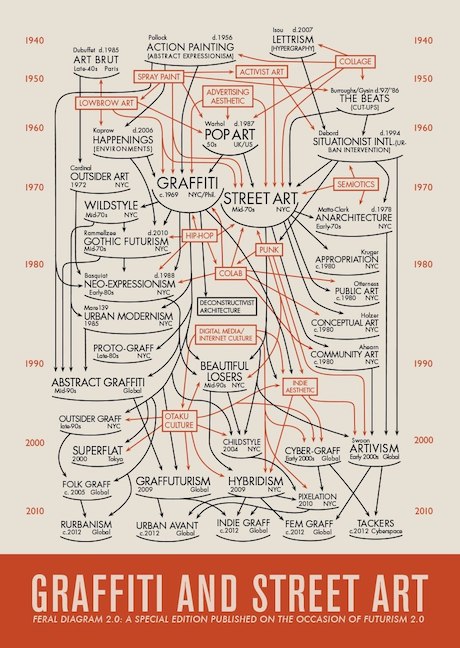 Theorist Daniel Feral rewrites art history, using the language of MoMA’s first director.
Theorist Daniel Feral rewrites art history, using the language of MoMA’s first director.
BY KELSEY CAMPBELL-DOLLAGHAN2 for Fast Company
In the annals of “Fine Art History,” graffiti is usually placed squarely outside of the mainstream dialogue. Usually, it’s relegated to a foggy category sometimes called Urban Art–or worse, Urban Contemporary. “Those are not terms that came from the graffiti or street communities,” says writer and theorist Daniel Feral. “They may be a result of categories created by the auction houses. I usually hear the terms used when discussing sales of art.”
Feral is the creator of the eponymous Feral Diagram, a map that revises the role of graffiti and street art in the canon of modern art. From Feral’s perspective, graffiti and street art have been critical drivers of the art world for well nigh 40 years now. Framing them as “outsider art” is not only lazy, but incorrect. As an alternative, Feral has literally redrawn art history, showing how 1960s graffiti and street art emerged from major mainstream movements, from Pop Art and the Situationists to 1940s Art Brut. By way of looping arrows and signs, he also demonstrates how street art evolved, conceptually, alongside the likes of Gordon Matta-Clark and Jenny Holzer. And thankfully, Feral also parses out the boilerplate-in-their-own-right terms, “graffiti and street art,” into specific groups and movements, like Wildstyle and Otaku-tinged Childstyle.
What’s clever about the Feral Diagram is that it utilizes the visual language of another very famous diagram, created by the first director of MoMA, Alfred H. Barr, in 1935. In his visualization, Barr used looping black arrows and Futura type to explain how Cubism and Abstract Art evolved from a mixture of high art and pop culture influences, ranging from Japanese prints to the Neo-Impressionists. “I wanted to honor Barr’s intellectual brilliance,” Feral writes. “By utilizing his visual language to tell a story other than that sanctioned by the Fine Art establishment, it made me feel like I was subverting the system too. It made me feel like I was doing what my friends were doing: reclaiming public space.”
